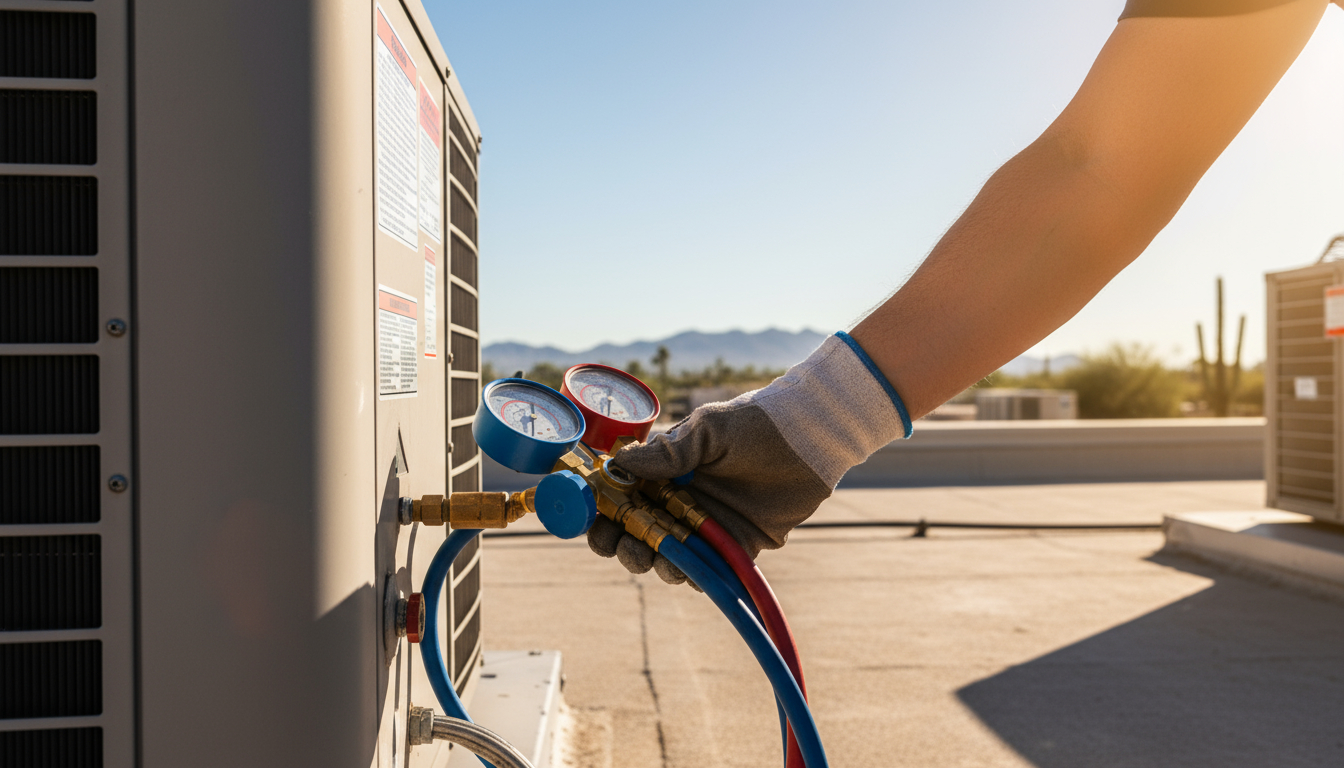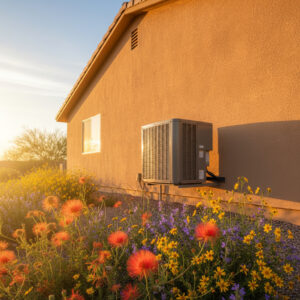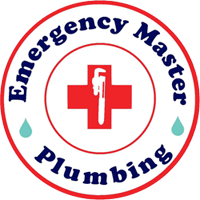

Maintaining your HVAC system is essential for Phoenix and Surprise homeowners, where extreme heat and dust can strain equipment and lead to costly breakdowns. This comprehensive checklist provides step-by-step guidance to keep your system running efficiently, helping you avoid common problems and ensure year-round comfort.
Phoenix and Surprise, Arizona, experience some of the hottest temperatures in the country, with summers often exceeding 100°F and dry, dusty conditions that challenge HVAC performance. Regular maintenance not only extends the life of your system but also improves energy efficiency, reduces utility bills, and enhances indoor air quality. In this guide, we’ll cover a detailed HVAC maintenance checklist tailored to the unique desert climate, including monthly tasks, seasonal preparations, and troubleshooting tips. By following these steps, you can prevent issues like refrigerant leaks, clogged filters, and thermostat malfunctions, saving you time and money in the long run.
Understanding HVAC Systems in Desert Environments
HVAC systems in Phoenix and Surprise must work harder due to the intense heat and low humidity. Air conditioners, heat pumps, and furnaces face constant stress from dust accumulation and temperature fluctuations. Without proper care, efficiency drops, leading to higher energy costs and potential health risks from poor air circulation.

Homeowners often overlook how the local environment affects their systems. For instance, blowing sand and pollen can clog components, while rapid cooling cycles in summer increase wear on compressors. Recognizing these factors is the first step in proactive maintenance. This checklist addresses these challenges by focusing on prevention and early detection, drawing from industry best practices to help you maintain a reliable system.
Monthly HVAC Maintenance Tasks
Consistency is key to avoiding unexpected failures. Perform these monthly checks to keep your system in top shape.
- Inspect and replace air filters. In dusty areas like Phoenix and Surprise, filters can clog quickly, reducing airflow and forcing the system to overwork. Check filters every 30 days and replace them if dirty to maintain optimal efficiency and air quality.
- Clean vents and registers. Dust buildup restricts airflow, so vacuum vents monthly and wipe them with a damp cloth to prevent blockages.
- Check thermostat settings. Ensure your thermostat is calibrated correctly; programmable models can save energy by adjusting temperatures when you’re away.
- Examine outdoor units. Clear debris like leaves or dirt from the condenser unit, and ensure at least two feet of clearance around it for proper ventilation.
- Listen for unusual noises. Rattling or humming sounds may indicate loose parts or motor issues—address them promptly to avoid bigger problems.
- Test system performance. Run your HVAC for a short period and monitor for even cooling or heating, noting any weak airflow that could signal duct problems.
These routine tasks take minimal time but can prevent up to 70% of common HVAC issues, according to energy experts.
Seasonal HVAC Maintenance Checklist
Arizona’s seasons bring specific demands on HVAC systems. Adapt your maintenance to prepare for each one.
Spring Preparation (March to May)
As temperatures rise, focus on transitioning from heating to cooling.
- Schedule a professional tune-up. Have a technician inspect refrigerant levels, clean coils, and lubricate moving parts to ensure summer readiness.
- Clean evaporator coils. Dust and grime accumulate over winter, so gently clean coils to improve heat exchange.
- Check drainage lines. Clear clogs in condensate drains to prevent water damage and mold growth.
- Test capacitors and electrical connections. Faulty components can cause system failures during peak heat.
Summer Maintenance (June to August)
Extreme heat means your AC works overtime—stay ahead with these steps.
- Monitor refrigerant levels. Low refrigerant often indicates leaks; recharge as needed to maintain cooling efficiency.
- Clean the condenser coils. High dust levels in Phoenix can coat coils, reducing performance—hose them down carefully.
- Ensure proper insulation. Check ductwork for leaks and add insulation where needed to keep cool air inside.
- Use ceiling fans. Supplement your HVAC by running fans to circulate air, reducing the system’s load.
Fall Tune-Up (September to November)
Prepare for cooler weather by shifting focus to heating components.
- Inspect the furnace or heat pump. Clean burners and check for cracks in the heat exchanger to prevent carbon monoxide risks.
- Replace weatherstripping. Seal doors and windows to retain heat and reduce energy waste.
- Calibrate the thermostat. Adjust for milder temperatures to avoid unnecessary cycling.
- Flush the drain pan. Remove algae or buildup to prevent overflows.
Winter Checks (December to February)
Even in mild Arizona winters, maintenance ensures reliable heating.
- Test the heating cycle. Run the system and verify even warmth throughout the home.
- Clean or replace humidifier pads if equipped, as dry air can affect comfort.
- Inspect belts and pulleys for wear, replacing them to avoid breakdowns.
- Check for drafts. Seal gaps around vents to maintain efficiency.
Tailoring maintenance to these seasons helps mitigate the effects of Phoenix’s arid climate, where temperature swings can stress systems.
Common HVAC Problems and Solutions for Local Homeowners
Phoenix and Surprise residents frequently encounter specific issues due to the environment. Here’s how to identify and resolve them.
Dust accumulation is a top concern, leading to reduced efficiency. Solution: Implement a regular cleaning schedule and consider high-efficiency particulate air (HEPA) filters for better filtration.
High energy bills often stem from inefficient systems. Solution: Conduct an energy audit—seal ducts, upgrade to energy-efficient models, and use smart thermostats to optimize usage.
Uneven cooling happens when ducts are blocked or the system is undersized. Solution: Clean ducts professionally and ensure your unit matches your home’s square footage.
Refrigerant leaks cause poor cooling and environmental harm. Solution: Never attempt DIY repairs; call a certified technician to locate and fix leaks while complying with EPA regulations.
Thermostat malfunctions can lead to inconsistent temperatures. Solution: Upgrade to a digital model and recalibrate annually.
Noisy operations might indicate failing motors or loose parts. Solution: Tighten connections and lubricate as needed, or replace worn components.
Addressing these problems early prevents escalation, ensuring your home remains comfortable despite the desert heat.
DIY vs. Professional Maintenance: What You Need to Know
While many tasks are suitable for DIY, knowing your limits is crucial for safety and effectiveness.
DIY-friendly activities include changing filters, cleaning vents, and clearing debris around units. These require basic tools and can be done safely by most homeowners.
However, tasks like refrigerant handling, electrical repairs, or coil cleaning demand professional expertise to avoid hazards like electrical shocks or refrigerant exposure. Professionals bring specialized tools and knowledge, ensuring compliance with local codes.
In Phoenix and Surprise, where systems endure heavy use, annual professional inspections are recommended. They can spot issues like Freon leaks or capacitor failures that DIY checks might miss.
Balancing DIY efforts with professional services maximizes system longevity and efficiency.
Benefits of Regular HVAC Maintenance
Consistent care yields significant advantages. Energy savings can reach 20-30% with clean, well-maintained systems, per the U.S. Department of Energy. Improved air quality reduces allergens, benefiting those with respiratory issues common in dusty areas.
Maintenance also extends equipment life, potentially adding years before replacement is needed. Fewer breakdowns mean less disruption, especially during heatwaves when repair wait times soar.
Investing time in this checklist promotes a healthier, more efficient home environment.
Conclusion: Take Control of Your HVAC Health
By following this HVAC maintenance checklist, Phoenix and Surprise homeowners can tackle the challenges of desert living head-on, ensuring reliable comfort and efficiency. Regular attention to your system prevents costly repairs and keeps your home cool in summer and warm in winter.
For expert assistance with your HVAC needs, we recommend Emergency Master Plumbing & Air. With their trusted services in the Phoenix area, they provide thorough maintenance, repairs, and installations. Contact them at 623-584-4706 to schedule an appointment and keep your system in peak condition.
